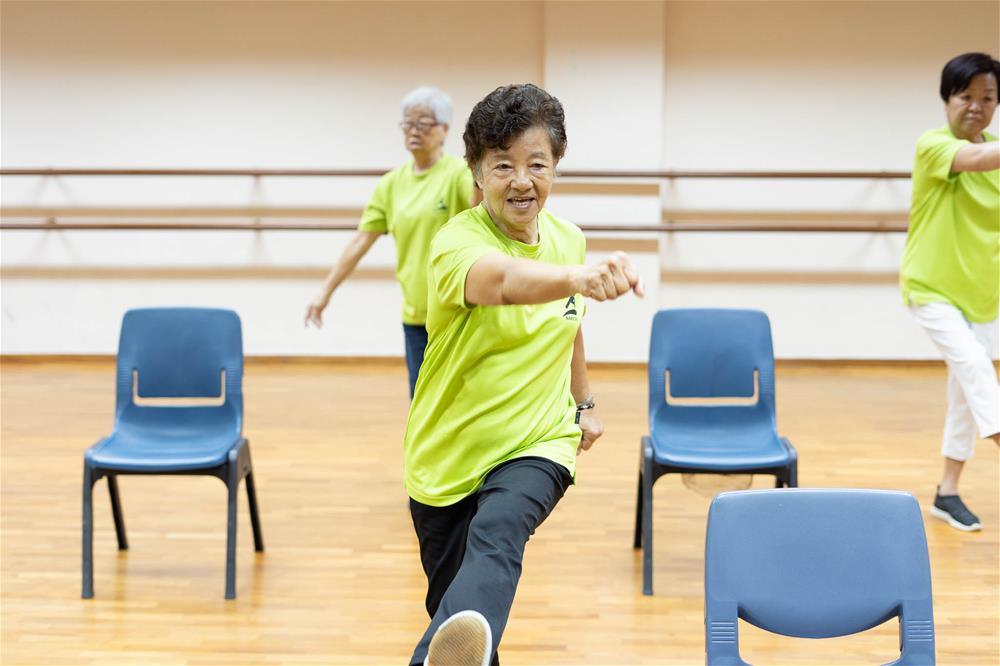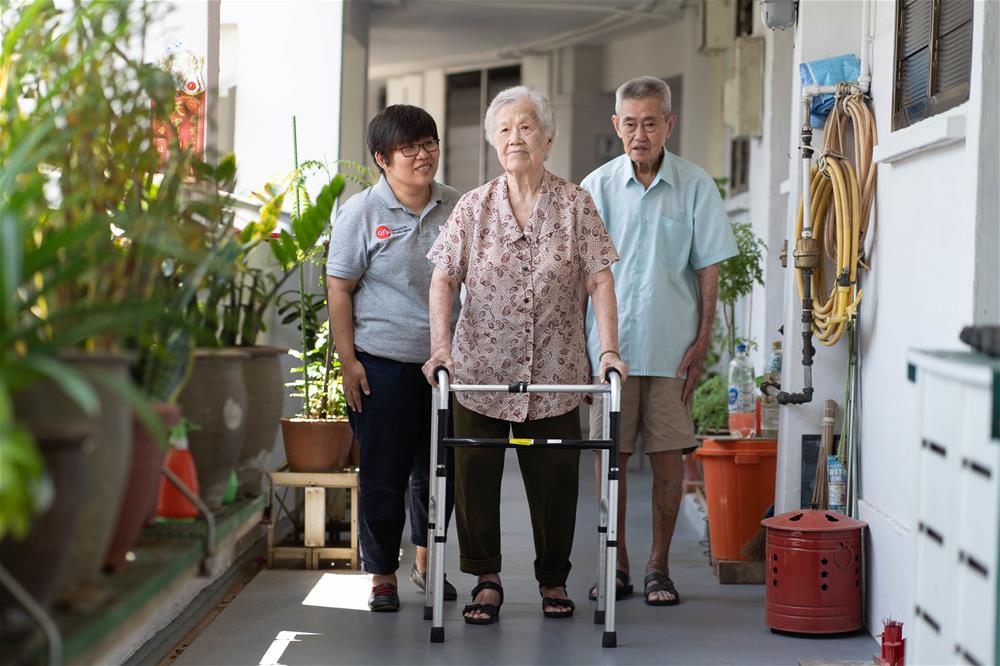No secrets to ageing well
By Anna Murphy, Freelance writer
Two befrienders talk to an elderly woman as part of the We Are Bonded study conducted by the Centre for Ageing Research & Education (CARE) to evaluate an asset-based intergenerational befriending programme // Credit: Zakaria Zainal
In 2015 at the age of 85, Chan Meng Hui became a poster-boy for ‘successful ageing’, completing his 101st marathon with thumbs up and a smile at the finish line. While nothing takes away from his personal accomplishment, such success stories are beyond the reach of many in his cohort of seniors.
The reality most people in their eighties have to contend with is filled with a multitude of physical, mental and financial obstacles, many of which set root much earlier in life. In fact, two nationwide studies, conducted by the Centre for Ageing Research and Education (CARE) at Duke-NUS, provide a snapshot of what older age looks like in 2009 and 2016-2017. The researchers found that the proportion of older people having difficulty with activities of daily living as well as those affected by chronic diseases has gone up.
So, when the media signals what successful ageing looks like, the majority of seniors would fairly feel that they are not winning any prizes.
The silent generation of original hustlers hang on in a land once again unfamiliar
‘Uncle Chan’, as he was affectionately known, belonged to a stoic cohort of older people, also known as Singapore’s pioneer generation.
This generation also includes a group of centenarians, born and raised between 1908 and 1923, who are characterised by a will to survive and a resilience that saw them through war and economic depression.
They are the “original hustlers”, in the words of Dr Ad Maulod, cultural anthropologist and senior research fellow at CARE, who co-led a study into the life experiences of centenarians in Singapore and Sydney, funded through a partnership between the University of Sydney and the National University of Singapore.
This generation, the researchers found, has a capacity for adaptability built on adversity. Many of those who are centenarians in Singapore today had arrived from overseas to a country that was rapidly changing. They contended with World War II, survived the Japanese Occupation and adjusted to the former colony’s transition to independence.
One 96-year-old in the study said: “My family had eight people, seven were shot—three younger brothers, three younger sisters, and my mother. When the Japanese ruled Singapore, we didn’t have rice to eat for three years and eight months. We only ate the sweet potatoes.”
Not only did these centenarians live through hardships that have not been experienced in Singapore since, many have also witnessed their roles in life disappear, neighbourhoods razed and rebuilt, not to mention the introduction of all the gadgetry that now holds the key to everyday life.
One participant, a Chinese female aged 103 years, lamented to Ad: “Being alive is the most difficult thing to do; it is useless to be alive.”
“Society romanticises longevity just as it throws a cloak of invisibility over the true experience of the oldest old,” said Ad.
Assistant Professor Rahul Malhotra, CARE’s head of research agrees. “The perception [of ageing] gets clouded or biased by what the discourse is in society,” he said. “If society paints the picture of an 85-year-old gentleman who runs marathons as someone who has aged successfully, then you may feel less likely to report that you have aged successfully because you can’t really do that or even one tenth of that.”
Society’s deep-rooted expectations of the oldest old—those in their late 80s, 90s—play into that. The expectation that these people should spend their living days at home, kept safe, being cared for rather than promoting their independence.
“Beyond a certain age, society seems to forget that the oldest old are capable of contributing to society, communicating and being engaged. There is a dearth of appropriate and meaningful programmes to engage and involve them in the community,” commented Ad.
But change is afoot, with some 70 campaigns focusing on all areas of life—from transport to work and health—having been rolled out to help promote successful ageing. The built environment, too, has come under close scrutiny. From public housing flats, whose diminishing size makes multi-generational living and caring in the home challenging, to the lack of resting spots along pedestrian walkways, and the long detours wheelchair users are forced to contend with—older people are often pincered.
“Barrier-free access is improving but more needs to be done for the environment to promote independence in the community,” said Ad.
Education and literacy begets better outcomes in later life
While improvements to the built environment and access to services is spearheaded by government intervention and big-picture city planning, the other prominent factor that has far-reaching impact on an older person’s experience of their later years is their socio-economic status. Higher status affords a precious commodity called choice that enables them to remain in better mental and physical health for longer as well as the means to do more with their time.
“Socio-economic status is underpinned primarily by education,” said Malhotra. “Literacy offers access to information, wider job opportunities and with that, higher income and standard of living. In turn, this affords, better awareness of self-care.”
Increasing the ability for self-care through better education and improved health literacy as early as during young adulthood could have significant impact for both men and women, even though their health outlook is quite different.
Malhotra explained: “When it comes to the duration of healthy life years, we do see that men are more advantaged in the sense that they live less long, but spend a greater proportion of life in better health.”
While men die earlier from fatal health events like heart attacks and strokes, women are more likely to develop degenerative health conditions like osteoarthritis. Yet, all of these can be mitigated through greater health literacy and lifestyle choices—quitting smoking, exercising more—and healthy eating habits.

A participant in the "Steps to avoid falls in the elderly: translating research into practice" study takes part a series of exercise programmes targeted to improve strength and balance so that she can be active and mobile // Credit: Zakaria Zainal
Not just caring for the body, but also the mind
However, a positive experience of older age is not just dependent on physical health. Mental wellbeing and a sense of belonging are also key.
While data from two key studies published by CARE found that psychological health and loneliness had improved among older Singaporeans before the pandemic, they are concerned that the social restrictions over the last two years may have adversely affected this trend.
And loneliness and social isolation among older people are particularly concerning because they have knock-on effects on physical health too.
“We found that lonely older adults can expect to live a shorter life than their peers who don’t perceive themselves as lonely,” summarised Malhotra, who was the study’s lead author. “Furthermore, they pay a penalty for their shorter lives by forfeiting potential years of good health.”
Digital, the silver-lining of COVID-19
While the pandemic blew the lid off the simmering mental health crisis, it extended an opportunity to rapidly introduce changes that could have a significant impact on access to care for older people. When in-person channels were shut down, the care force pivoted to online options to deliver services to seniors. Malhotra calls this “the silver lining of COVID-19”.
In a short two years, the landscape roared into the future where medicines are delivered and healthcare needs met remotely.
“I think digitalisation has both good and bad aspects. It’s definitely helpful for families and older people, because a lot of services that they would have had to otherwise attend to physically, they can now do online,” said Malhotra, who served on the World Economic Forum’s Global Future Council on Healthy Ageing and Longevity, which shaped conversations on COVID-19 and ageing societies and developed good practices to help older adults thrive during and after the pandemic.
“At the same time, digitalisation poses a challenge,” he added, “because I think half of all the people aged 65 and older in Singapore still can’t read in English. Access to such devices, lack of familiarity or navigation issues are all challenges older people face with digitalisation today–I mean simply because those tools didn’t exist before.”
The government, too, has stepped in. Its SG Digital Office provides smartphones and wifi, and teaches basic skills to seniors. This scheme relies on digitally progressive seniors to help onboard less-capable peers to online services, activities and interest groups.
And for those who are bedridden, digital technology could be used to strengthen social ties, believes Ad as these seniors can be engaged in programmes that can be done at home, reducing their risk of loneliness and isolation.
With new tools—like the acceptance of video calling—to extend interactions, many in the care sector hope to be able to turn the tide on the growing social isolation faced by seniors today and well into the future.
Establishing targeted guidelines for ageing healthcare is another way to enrich life for older people. In Singapore’s multi-cultural population, this means curated activities according to age, ability, spoken language and interests, so as to engage the individual on all fronts physically and intellectually for as long as possible.

Credit: Zakaria Zainal
Caring better for the future old
More than just having new tools to deliver care more frequently and through different means, Malhotra suggests that, at an individual level, widening the scope of health screenings could be impactful, so that those who are experiencing feelings of loneliness can be better supported.
“Or they could be prompted to ask themselves questions about whether they feel left out from activities that those around them are engaged in, and just acknowledge that and reach out to immediate family and friends,” he added, with additional help available to those who continue to feel this way.
Ensuring that care that focuses on improving quality of life rather than just prolonging life is also needed. Interventions that enable people to remain mobile and active should remain accessible.
And training future doctors who are able to connect, understand and care for older people will also be key. That may require additional modules focusing on people older than 70 and for students to immerse themselves in community activities.
“Actually, I like to think about longevity rather than ageing because people tend to use the word ageing in a negative way. But we're really talking about a success story that we get to live 20, sometimes 30 years longer. So, we should think about how we can take advantage of these extra years of life, and how we optimise the benefit of living a long life.”
Dr Mary Ann Tsao, Chairperson, Tsao Foundation
At the heart of the journey of ageing, however, lies the individual’s lived experience.
Malhotra observed: “Even an individual who has a decent number of medical conditions, or a limited social circle, but who is perfectly happy with his or her situation, and is satisfied with what they have at this point, has aged successfully.”